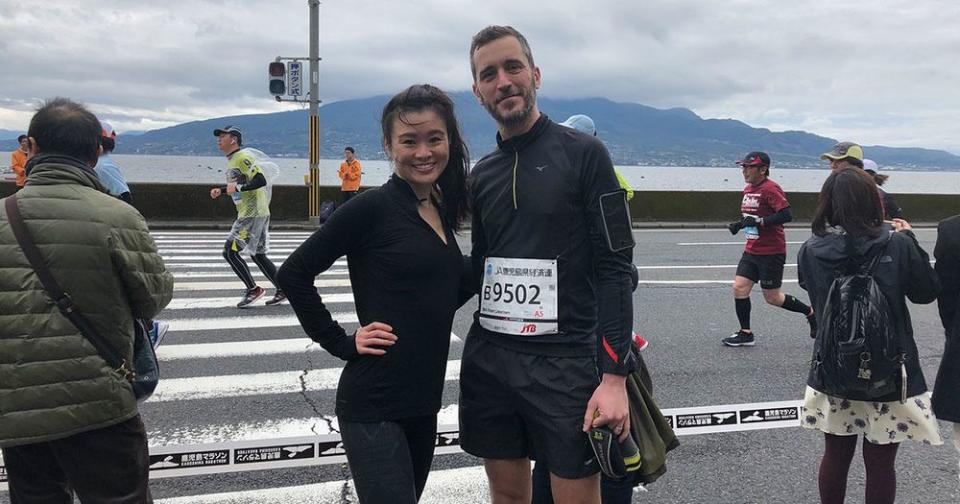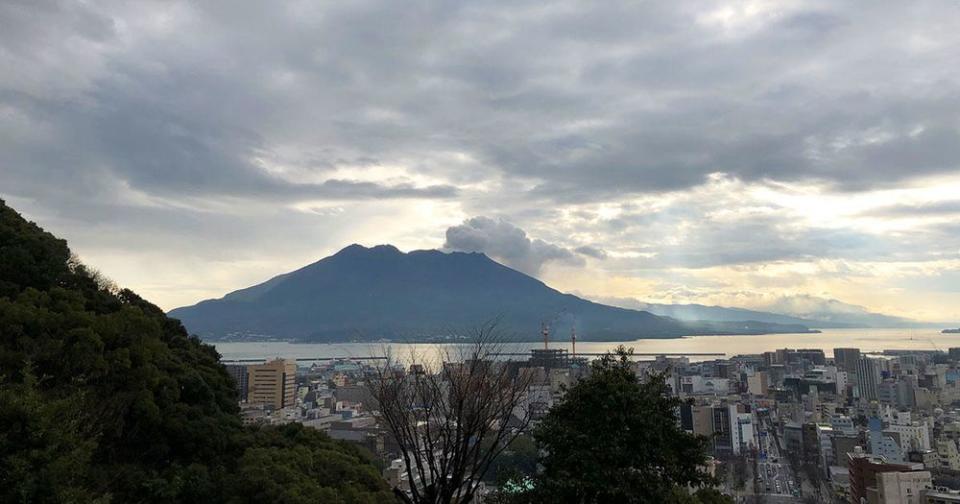I Didn't Finish My First Marathon—and I'm Super Happy About It
Photos: Tiffany Leigh

I never imagined I would run my first marathon in Japan. But fate intervened and fast forward: I'm surrounded by a sea of neon green running shoes, determined faces, and Sakurajima: an active volcano hovering over us at the starting line. Thing is, this race *almost* didn't happen. (Ahem: 26 Mistakes *Not* to Make Before Running Your First Marathon)
Let's rewind.
Since I was young, cross-country running was my thing. I fed off the high from hitting that sweet stride and pace, along with being zenned out from absorbing my natural environment. By college, I was clocking an average of 11 to 12 miles daily. Soon, it became clear I was pushing myself too hard. Every evening, my dorm room would be full with the odors of a Chinese apothecary, thanks to the endless string of numbing ointments and massages I tried to soothe my aches and pains.
The warning signs were everywhere—but I stubbornly chose to ignore them. And before I knew it, I was saddled with shin splints so severe that had to wear a brace and get around with a crutch. Recovery took months, and in that stretch of time, I felt as though my body had betrayed me. Soon, I gave the sport the cold shoulder and picked up other modes of low-impact fitness: cardio at the gym, weight training, yoga, and Pilates. I moved on from running, but I don't think I ever truly made peace with myself or forgave my body for this self-perceived "failure."
That is, until I ran this marathon in Japan.
The Kagoshima marathon has been held annually since 2016. Interestingly, it lands on the exact same date as another major event: the Tokyo marathon. Unlike the big-city vibes of the Tokyo race (one of the five Abbott World Marathon Majors), this charming prefecture (aka region) is located on small Kyushu Island (about the size of Connecticut).
Upon arrival, you'll immediately be in awe of its beauty: It features Yakushima Island (considered the Bali of Japan), landscaped gardens like the famed Sengan-en, and active volcanoes (the aforementioned Sakurajima). It is considered the kingdom of hot springs in the prefecture.

But why Japan? What makes it the ideal location for my first marathon? Well, it's über-cheese to admit this, but I have to hand it to Sesame Street and a special episode titled "Big Bird In Japan." That tall ray of sunshine had me positively enchanted with the country. When I was presented with the opportunity to run Kagoshima, the kid in me made sure I said "yes"—even though I didn't have enough time to adequately train.
Luckily, as far as marathons go, Kagoshima, in particular, is a pleasant run with minimal elevation changes. It's a smooth course compared to other big races around the world. (Um, like this race that's equivalent to running four marathons up and down Mt. Everest.) It's also far less crowded with only 10,000 participants (compared to the 330K that raced Tokyo) and, as a result, everyone is incredibly patient and friendly.
And did I mention that you're running alongside an active volcano—Sakurajima—which is only about 2 miles away? Now that's pretty damn epic.
I didn't really feel the gravity of what I'd committed to until I picked up my bib in Kagoshima City. That old "all-or-nothing" attitude from my past running career was cropping up again—for this marathon, I told myself I wasn't allowed to fail. This type of mindset, unfortunately, is precisely what resulted in injury in the past. But this time, I had a few days to process before the start of the run, and it seriously helped me relax.
The ultimate race prep.
To prep, I took a train an hour south into Ibusuki, a seaside city by Kagoshima Bay and (inactive) Kaimondake volcano. I went there to hike and to decompress.
Locals also encouraged me to go to Ibusuki Sunamushi Onsen (Natural Sand Bath) for a much-needed detox. A traditional social event and ritual, the "sand bath effect" is proven to alleviate asthma and improve blood circulation among other conditions, according to research done by Nobuyuki Tanaka, emeritus professor at Kagoshima University. This would all benefit my run, so I gave it a go. The staff shovels naturally heated black lava sand all over your body. Then you "steam" for about 10 minutes to release toxins, let go of negative thoughts, and relax. "The hot springs will comfort mind, heart, and soul through this process," says Tanaka. Indeed, I felt more at ease afterward. (P.S. Another resort in Japan also lets you soak in craft beer.)
The day before the marathon, I ventured back into Kagoshima City over to Sengan-en, an award-winning Japanese garden known to promote states of relaxation and center your Reiki (life-force and energy). The landscape was definitely conducive to soothing my inner pre-race nerves; while hiking to Kansuisha and Shusendai Pavilions, I was finally able to tell myself it was okay if I didn't—or couldn't—finish the race.
Rather than beat myself up, I acknowledged how important it was to listen to my body's needs, to forgive and accept the past, and to let go of all that anger. I realized it was victory enough that I was participating in the run at all.

Time to run.
On race day, the weather gods took mercy on us. We were told it was going to torrentially rain. But instead, when I opened my hotel blinds, I saw clear skies. From there, it was smooth sailing to the starting line. The property I stayed at (Shiroyama Hotel) had a pre-race breakfast and also managed all the transportation logistics of getting to and from the marathon site. Phew!
Our shuttle bus wound toward the city center and we were greeted like celebs with a sensory-overload of life-size cartoon characters, anime robots, and more. Being smack-dab in the middle of this anime chaos was a welcome distraction to quell my nerves. We made our way toward the starting line and, just minutes before the race began, something wild happened. Suddenly, in the corner of my eye, I saw a billowing mushroom cloud. It was coming from Sakurajima. It was an ash rainfall(!!). I guess it was the volcano's ways of announcing: "Runners… on your marks… get set..."
Then the gun blasts off.
I'll never forget the first moments of the race. At first, you're moving like molasses due to the sheer volume of runners packed together. And then very suddenly, everything zips toward lightning speed. I glanced out at the sea of people before me and it was an unreal sight. Over the next few miles, I had a few out-of-body experiences and thought to myself: "Wow, am I actually doing this??" (Here are other thoughts you will probably have while running a marathon.)
My run was strong until the 17K mark when the pain started to kick in and my knees begin to buckle—it felt as if someone was taking a jackhammer to my joints. The "old me" would have plowed through stubbornly and angrily, thinking "injury be damned!" Somehow, with all that mental and meditative preparation, I opted not to "punish" my body this time, but listen to it instead. In the end, I managed about 14 miles, a little over half. I didn't finish. But over half? I felt pretty proud of myself. Most importantly, I didn't beat myself up afterward. In light of prioritizing my needs and honoring my body, I walked away with pure happiness in my heart (and no further injuries to my body). Because this first experience was so enjoyable, I knew that there could always be another race in the future.

